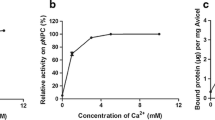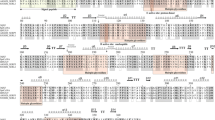Abstract
Cytophaga hutchinsonii was originally isolated from sugarcane piles. This microorganism therefore probably produces an array of enzymes allowing it to digest cellulosic substrates. C. hutchinsonii thus represents a rich source of potentially effective cellulase enzymes that can be harnessed for conversion of biomass to simple sugars. These sugars can then be used as feedstock for ethanol production or other chemical syntheses. In this study, we report the PCR cloning of an endoglucanase gene (Cel9A) from C. hutchinsonii using degenerated primers directed at the catalytic domain. Alignment of the amino acids sequence revealed that Cel9A has a gene structure totally different from the other known cellulose degraders. The most striking feature of this cloned protein is the absence of a cellulose-binding domain (CBD), which to date was believed to be imperative in cellulose hydrolysis. Consequently, the Cel9A gene, encoding β-1,4 endoglucanase from C. hutchinsonii was over-expressed in Escherichia coli with a His-Tag based expression vector. The resulting polypeptide, with a molecular mass of 105 KDa, was purified from cell extracts by affinity chromatography on cellulose. Mature Cel9A was optimally active at pH 5.0 and 45°C. The enzyme efficiently hydrolyzes carboxymethyl-cellulose (CMC). Analysis of CMC and filter paper hydrolysis suggests that Cel9A is a nonprocessive enzyme with endo-cellulase activities.
Similar content being viewed by others
References
Wilson, D. B. and Irwin, D. (1999), Adv. Biochem. Eng. Biotech. 65, 1–21.
Lynd, L. R. (1996), Annu. Rev. Energy Environm. 21, 403–465.
Leschine, S. B. (1995), Annu. Rev. Microbiol. 49, 399–426.
Knowles, J., Lehtovaara, P., and Teeri, T. (1987), Trends Biotechnol. 5, 255–261.
Glick, B. R. and Pasternak, J. J. (1989), Biotech. Adv. 7, 361–386.
Lynd, L. R., Weimer, P. J., Willem, H., van Zyl, W. H., and Pretorius, I. S. (2002), Microb. Mol. Bio. Rev. 66, 506–577.
Sambrook, J., Fritsch, E. F., and Miniatis, T. (1989), in Molecular Cloning—A laboratory Manual, Second ed. Cold Spring Harbor Laboratory Press, Cold Spring Harbor, NY.
Dnastar (2002), Lasergene software, www.DNASTAR.com.
Clustalw (2002), EBI—European Bioinformatics Institute. www.ebi.ac.uk/clustalw.
CodeHop (2002), Consensus Degenerate Hybrid Oligonucleotide Primers— www.bioinformatics.weizmann.ac.il/codehop.html.
Qiagen. DNA Cleanup Protocol (2003), www.qiagen. com/Products/DnaCleanup.
Genecodes (2002), Sequencher. www.genecodes.com/ sequencher.
Promega (2003), pGEM-T and pGEM-T Easy Vector Systems Technical Manual, TM042. www.promega.com/tbs/tm042/tm042.pdf.
Novagen (2003), pET28 His-Tag Vector system Manual, www.novagen.com.
Zhou, W., Irwin, D., Kousen, J. E. and Wilson, D. B. (2004), Biochemistry 43, 9655–63.
NIH (National Institute of Health) (2002), National Center for Biotechnology Information. www.ncbi.nlm.nih.gov.
PROSITE. Expasy Proteomics Server (2002), www.expasy.org/prosite.
Miller, G. L. (1959), Anal. Chem. 31, 426–428.
Bradford, M. (1976), Anal. Biochem. 72, 248–252.
Lowry, O. H. and Rosenbrough, A. L. (1951), J. Biol. Chem. 193, 265–275.
Wilson, D. B. (2004), The Chemical Record, 4, 72–82.
CBS—Center for Biological Sequence Analysis (2005), www.cbs.dtu.dk/services/SignalP
Rosano, C., Bisso, A., Izzo, G., et al. (2000), J. Mol. Biol. 303, 77–91.
Henrissat, B., Claeyssens, M., Tomme, P., Lemesle, L., and Mornon, J. P. (1989), Gene 81, 83–95.
Degani, O., Gepstein, S., and Dosoretz, C. (2004), J. Biotechn. 107, 265–273.
Lu-Shan, W., Jie, L., Yu-Zhong, Z., Yue, Z., and Pei-Ji, G. (2003), J. Mol. Catal., B Enzym. 24, 27–38.
Cavaco-Paulo, A., Morgado, J., Andreaus, J., and Kilburn, D. (1999), Enzyme Microb. Technol. 25, 639–643.
Carrard, M. L., Forro, L. M., and Pekker, S. (1996), Synthetic Metals 80, 29–34.
Lemos, M. A., Teixeira, M. R. M., Domingues, M., and Gama, F. M. (2003), Enzyme Microb. Technol. 32, 35–40.
Linder, M. and Teeri, T. (1997), Proc. Natl. Acad. Sci. USA 93, 12,251–12,255.
Kerita, S., Kazuo, S., and Kunio, A. (1996), J. Ferment. Bioeng. 81, 553–556.
Author information
Authors and Affiliations
Corresponding author
Rights and permissions
About this article
Cite this article
Louime, C., Abazinge, M., Johnson, E. et al. Molecular cloning and biochemical characterization of a family-9 endoglucanase with an unusual structure from the gliding bacteria Cytophaga hut chinsonii . Appl Biochem Biotechnol 141, 127–138 (2007). https://doi.org/10.1007/s12010-007-9215-3
Issue Date:
DOI: https://doi.org/10.1007/s12010-007-9215-3




